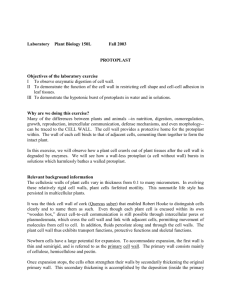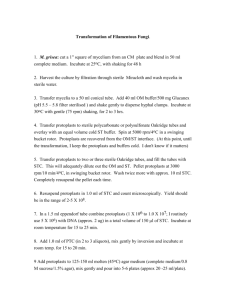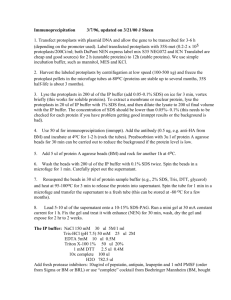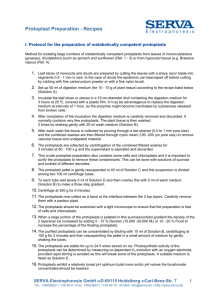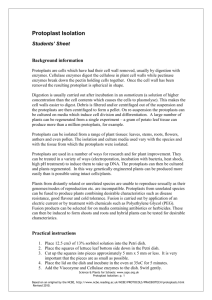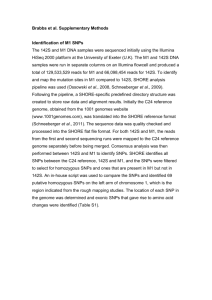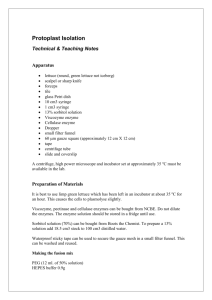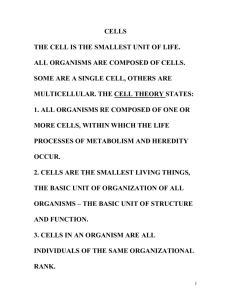A simple method for the isolation of plant protoplasts J. Biosci.,
advertisement
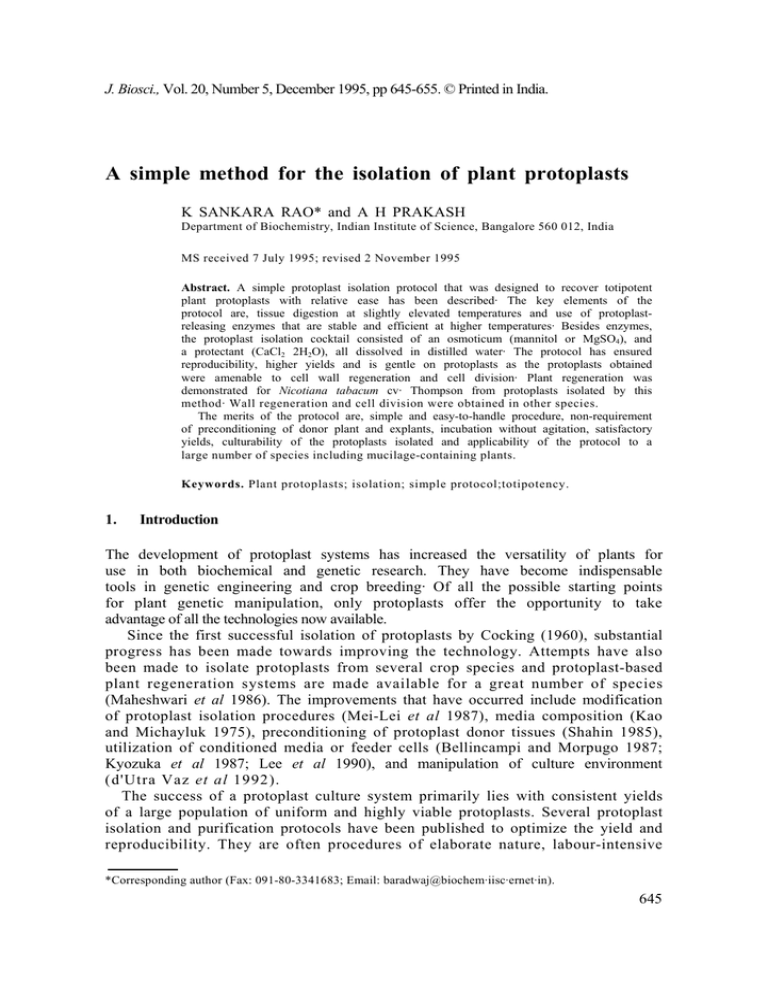
J. Biosci., Vol. 20, Number 5, December 1995, pp 645-655. © Printed in India. A simple method for the isolation of plant protoplasts K SANKARA RAO* and A H PRAKASH Department of Biochemistry, Indian Institute of Science, Bangalore 560 012, India MS received 7 July 1995; revised 2 November 1995 Abstract. A simple protoplast isolation protocol that was designed to recover totipotent plant protoplasts with relative ease has been described· The key elements of the protocol are, tissue digestion at slightly elevated temperatures and use of protoplastreleasing enzymes that are stable and efficient at higher temperatures· Besides enzymes, the protoplast isolation cocktail consisted of an osmoticum (mannitol or MgSO4), and a protectant (CaCl2 2H2O), all dissolved in distilled water· The protocol has ensured reproducibility, higher yields and is gentle on protoplasts as the protoplasts obtained were amenable to cell wall regeneration and cell division· Plant regeneration was demonstrated for Nicotiana tabacum cv· Thompson from protoplasts isolated by this method· Wall regeneration and cell division were obtained in other species. The merits of the protocol are, simple and easy-to-handle procedure, non-requirement of preconditioning of donor plant and explants, incubation without agitation, satisfactory yields, culturability of the protoplasts isolated and applicability of the protocol to a large number of species including mucilage-containing plants. Keywords. Plant protoplasts; isolation; simple protocol;totipotency. 1. Introduction The development of protoplast systems has increased the versatility of plants for use in both biochemical and genetic research. They have become indispensable tools in genetic engineering and crop breeding· Of all the possible starting points for plant genetic manipulation, only protoplasts offer the opportunity to take advantage of all the technologies now available. Since the first successful isolation of protoplasts by Cocking (1960), substantial progress has been made towards improving the technology. Attempts have also been made to isolate protoplasts from several crop species and protoplast-based plant regeneration systems are made available for a great number of species (Maheshwari et al 1986). The improvements that have occurred include modification of protoplast isolation procedures (Mei-Lei et al 1987), media composition (Kao and Michayluk 1975), preconditioning of protoplast donor tissues (Shahin 1985), utilization of conditioned media or feeder cells (Bellincampi and Morpugo 1987; Kyozuka et al 1987; Lee et al 1990), and manipulation of culture environment (d'Utra Vaz et al 1992). The success of a protoplast culture system primarily lies with consistent yields of a large population of uniform and highly viable protoplasts. Several protoplast isolation and purification protocols have been published to optimize the yield and reproducibility. They are often procedures of elaborate nature, labour-intensive *Corresponding author (Fax: 091-80-3341683; Email: baradwaj@biochem·iisc·ernet·in). 645 646 K Sankara Rao and A H Prakash involving too many explant or protoplast handling steps, and require extended exposure of explant to digestion environment· Further, the efficacy of such protocols or that of enzyme combinations used therein could be limited to a few plant species· These restrictions must be overcome by improvement of the existing conditions and methods. A number of commercial cellulases and pectinases which allow protoplast release are available· By manipulating the source and concentrations of these, protoplasts may be released fro most tissues; however, generalizations cannot be made. The enzymes and techniques used for isolation of protoplasts have a bearing on their subsequent behaviour and development. Methods with too many steps involved often result in the introduction of cell contamination at some stage or the other. Here, we present a simple method in which slightly elevated temperatures and a set of new enzymes that are efficiency at higher temperatures have functioned synergistically to release protoplasts with relative ease in a number of plant species. The enzymes are hitherto not known as being used for protoplast isolation (Sankara Rao and Srikantha 1986). Consistently high yields of viable protoplasts from a variety of explants of taxonomically widely separate plants were demonstrated. The culturability of these protoplasts was examined. The overall efficiently and relative advantages of the method are discussed. 2. Materials and methods 2·1 Source tissue Tissue for protoplast isolation consisted of fully expanded leaves excised from greenhouse-grown plants (Basella, Centella, Withania, Amaranthus, Catharanthus, Phlox, Petunia) as well as from actively-growing shoot cultures (tomato cultivars viz·, Arkavikas, pusa Ruby and Punjab Kesari; chilli, Nicotiana rustica, N. glutinosa and N· tabacum cv. Thompson), cotyledons of aseptically-germinated seedlings (sunflower and niger), placental tissue of fruits (tomato) and friable embryogenic callus (sandalwood). Shoot cultures were stabilized in vitro· The culture conditions and media for the shoot cultures of each species were as follows. Surface sterilized seeds of N. tabacum cv Thompson, N. rustica and N. glutinosa were germinated on half strength MS medium for explanting shoots· Thereafter, shoot cultures were maintained by routine subculture onto the same medium viz., half strength MS medium. Leaves were obtained for protoplast isolation 3-4 weeks after every subculture· Tomato axillary shoots were obtained from 3–4 weeks old greenhouse grown plants and taken to culture in half strength MS medium. Surface sterilized seeds of sunflower and niger were germinated on half strength MS medium. Seeds were dark-incubated for germination and were shifted to 14 h exposure to light of 200 µEm-2 s - 1 intensity at 25 ± 2°C temperature. Rapidly-growing embryogenic sandalwood callus was obtained from foully developed endosperm as tissue explant. Callus was induced on MS medium incorporated with 2,4-dichlorophenoxyacetic acid (2,4-D) (1 mg/1) and kinetin (0·5 mg/1) and then transferred to MS medium supplemented with 1 mg/1 of 2,4-D for eliciting embryogenic competence. Method for plant protoplast isolation 647 2.2 Explant preparation prior to enzyme exposure Leaves of field-grown plants were thoroughly washed in running water for about 10 min, cleaned gently with dilute Labolene of Glaxo India Ltd., and quickly rinsed with tap water first and then with deionized water· Sterilization was carried out with 2% sodium hypochlorite for 5 min followed by several rinses with sterile distilled water. Surface decontaminated leaves of greenhouse plants as well as those excised from shoot cultures were chopped into 2-3 mm strips in most cases. But leaves with epidermal layers peeled off were also used except in Basella, Centella, Amaranthus, tomato, and chilli where peeling was not very efficient. Cotyledons of sunflower, niger, chilli seedlings and placental tissue of tomato fruits were similarly chopped into segments for enzymatic digestion· The embryogenic callus of sandalwood was lightly squashed with a spatula and dropped into protoplast isolation solution. All tissues were weighed in sterilized petriplates for fresh weight determination before they were subjected to enzyme digestion. 2.3 Protoplast isolation, purification and culture The protoplast isolation solution consisted of digesting enzymes, the osmoticum, a protecting chemical, CaCl 2 (10 mM), all dissolved in distilled water. 2.3a Enzymes: The digesting enzymes used viz·, cellulase and pectinase (Celluclast and Pectinex/SP249) are a gift from Novo Industri (Denmark)'s Regional Liaison Office, 101, 'Shah Sultan', Cunningham Road, Bangalore. These are liquids and are readily and completely miscible with water at all concentrations which occur in normal usage. The optimal working conditions with these enzymes viz., temperature and pH are ideally suited for their use in protoplast isolation. 2.3b Osmotic conditions (stabilization): Osmotic stabilization was manipulated by adding to the protoplast isolation and culture solutions, mannitol as the sole osmoticum or mannitol in combination with either sorbitol or magnesium sulphate. For tobacco leaves, niger cotyledons and sandalwood callus, mannitol alone was finally used as the osmoticum. Balancing of isolation and culture media to protoplast isotonic concentration was carried out for different species and explants individually using a cryoscopic osmometer (Osmomat 030 Gonotec) (tables 1 and 2). 2·3c Incubation for protoplast release: Protoplasts were isolated by incubating the various explants in filter sterilized isolation solution. Incubation was carried out in dark at temperatures of 25 ± 1°C initially. To determine the time required for complete release of protoplasts at incubation temperatures 25 ± 1°C, aliquots were microscopically examined at different time points for all the species/explants studied (table 1). To identify factors that might influence the efficiency in terms of protoplast release, rapidity and viability, incubation of tobacco leaf tissue was carried out at different temperatures, at pH ranging from 5·6 to 6 and with different osmotic stabilizers used either singly or in combination. The quantity and the ratios of enzymes required for protoplast release were also determined. 648 K Sankara Rao and A H Prakash Method for plant protoplast isolation 649 650 K Sankara Rao and A H Prakash Table 2. Media used for protoplast isolation and culture*. *Media based on modified 8E formulation. **Osmolarity for plating protoplasts of N. tabacum cv Thompson and G. abyssinica. 2.3d Protoplast purification: The suspension of digested tissue in the isolation mixture was sieved through a nylon mesh of appropriate pore size to remove the debris and the filtrate was centrifuged at 100 g for 5 min to further separate the protoplasts from fine debris that remained floating. The pellet of protoplasts was resuspended in 5 ml of washing medium (table 2) and the process was repeated three times. The protoplasts in 2 ml of washing medium were then layered on 9 ml of flotation medium (table 2) in 15 ml capacity glass screw cap vials. The tubes were left undisturbed for 15 min and then centrifuged at 160 g for 10 min. The floating protoplast fraction that formed a clear band at the interphase of washing and flotation medium was recovered with a Pasteur pipette and was mixed with equal volume of fresh wash medium. Protoplasts at this stage were allowed to equilibrate in the wash medium in dark for about 30 min before they were plated. The density and the yield of protoplasts were estimated using a hemocytometer and the plating density adjusted. The competence and viability of protoplasts was determined by dye testing (the viability test with fluorescein diacetate (FDA)). Protoplast isolation by this method was compared with that obtained by a standard method (Sankara Rao and Gunasekari 1991). Leaf explants of tobacco and tomato axenic shoot cultures raised under identical conditions were digested by these two methods and the digestion time, and the yield at different temperatures were Determined. 2·3e Protoplast culture: Aliquots of purified protoplasts were plated in 2 ml of modified 8E liquid culture medium (Niedz et al 1985) supplemented with appropriate growth regulators and taken into 60 × 15 mm plastic or glass petriplates (table 2). The osmolarity of the culture medium was adjusted for each species separately by adding appropriate amounts of mannitol. The plating density was adjusted to obtain 2 × 104 protoplasts per ml of medium. The cultures were initially incubated in dark at 25 ± 2°C temperature for two weeks and then shifted to alternating light (of Method for plant protoplast isolation 651 intensity 200 μΕm–2 s–1) and dark regimes of 14 and 10 h respectively. Samples were tested periodically for viability and wall regeneration· Further culturing of protoplasts to obtain cell colonies and plant regeneration was followed for N. tabacum cv Thompson applying the procedure described earlier by Sankara Rao and Gunasekari (1991). All media were autoclaved for 15 min at 15 p.s.i. Growth regulators used were filter sterilized. All operations were carried out under aseptic conditions. 3. Results The results obtained from the various protoplast isolation experiments performed are summarized in table 1. With the method described now, tissues of species explanted were most readily acted upon by the enzymes and microscopic examination carried out following digestion showed that the protoplast release was complete. All species investigated yielded protoplasts (figures 1, 2, 5 and 6). These species include herbaceous dicotyledonous plants, woody sandalwood and the mucilage-containing herbaceous vine, Basella. On an average, the incubation time required for complete release of protoplasts varied between 4 and 10 h depending on the species examined. Protoplast release from the explants of N. tabacum, Lycopersicon esculentum cultivars and Capsicum frutescens cultivars, particularly, needed only 4-6 h. Digestion of these explants carried out by another method which was adopted earlier by Sankara Rao and Gunasekari (1991) required a longer time (8-12 h) for protoplast release (table 1). The yield of protoplasts was also comparatively low. The Novo enzymes used in the present method maintained protoplast releasing ability at temperatures beyond 25°C. Increase of temperature during tissue incubation using these enzymes, in fact, aided tissue digestion further. The yield of protoplasts also increased slightly in N. tabacum cv Thompson (table 1). More than its beneficial effect on protoplast yield, increased incubation temperature had reduced the time needed for complete release of protoplasts (table 1). The optimal conditions identified with the protocol were, an incubation temperature range between 28-30°C and a pH between 5·8 and 6. These were also conditions observed to be ideal for protoplast preparation from the plant species used in the experiments as the protoplast viability did not suffer the least. Using the present protocol, the yield of protoplasts derived from chopped explants as also from leaves with epidermal layers peeled off were comparable (table 1). Filtration of incubation mixture through nylon mesh reduced the amount of contaminating debris but only incompletely. That isolated protoplasts were free of cell walls was determined by microscopic observation. Virtually a pure population of intact protoplasts was readily isolated by flotation separation on sucrose. The yield data for each of the plant species used is shown in table 1. Washes and sedimentation helped further purification of the protoplast preparation. Protoplasts were most stable if allowed to equilibrate in the wash medium for about 30 min before plating. In aliquots of purified protoplasts tested for viability, a fairly good number were found positive. Protoplasts plated in modified 8E medium formed cell wall readily (figures 3, 4, 6 and 8). The growth regulators and osmolarity of the culture medium were different for each species/cultivar investigated. 652 K Sankara Rao and A H Prakash Figures 1-8. Protoplasts and protoplast-derived cells and cell colonies. (1-2) Freshly isolated protoplasts from Santalum album callus and Catharanthus roseus leaf mesophyll. Bar = 60µm. (3) First cell division (L. esculentum cv Arkavikas). (4) First cell division (C. frutescens cv Punjab Jwala). (5) Freshly isolated protoplasts (N. tabacum cv Thompson). (6) Protoplasts and first cell division (G abyssinica). (7) Protoplast-derived cell colony (G. abyssinica). (8) First cell division (N. tabacum cv Thompson). Protoplasts of niger, tobacco cultivars, C. frutescens cv Punjab Jwala and L. esculentum cv Arkavikas divided within six to seven days of culture· In tobacco, numerous cell colonies became visible after six weeks of culture (figures 8-11). Method for plant protoplast isolation 653 Figures 9-12. Plant regeneration from protoplasts of N. tabacum cv Thompson. (9-10) Small and large cell colonies. (11) Protoplast-derived calluses. (12) Calluses showing shoot organogenesis. Plants were regenerated for N. tabacum cv Thompson from the cell colonies (figures 11 and 12) as described earlier (Sankara Rao and Gunasekari 1991). 4. Discussion Most protoplast isolation protocols generally aim at higher yields, rapid recovery and regenerability of protoplasts so obtained. But all these objectives are seldom accomplished with any one method as there has been no demonstrated whole plant regeneration from protoplasts obtained by rapid preparations (Moore et al 1988; Hedrich et al 1985; Thirumala Devi et al 1992) and similarly, high-yielding protocols are rarely less simple procedures. Using the method described, we have overcome some of these problems. The protocol provides a simple and an easy-to-handle procedure that ensured satisfactory yields and quick recovery of viable protoplasts. 654 K Sankara Rao and A H Prakash The method owes its efficiency to elevated digestion temperatures and a set of new enzymes synergistically acting on tissues at these temperatures. The Novo cellulase and pectinase used are stable at higher temperatures. The rate of enzymatic digestion also increased with increase in incubation temperature. The tissue incubation, however, was carried out at temperatures at which protoplast viability remained unaffected. The time required for protoplast release was less than it was observed with methods utilizing other enzymes (Sankara Rao and Gunasekari 1991), tested on the same tissue under identical conditions. Thus, the extended periods required for enzymes to release protoplasts are avoided by this method and the protoplasts are protected from the deleterious effects of long-term exposure to digestion environment. The protocol is simple in that the various pretreatment steps such as preconditioning of donor plants, presoaking of explanted tissue, shaking during incubation, etc., were totally avoided. Generally different plant species require cell wall degrading enzymes from different sources. In the method presented, the same set of enzymes were found effective on many different and unrelated species equally well. Consistently, higher yields were obtained in all species investigated with an average of 6×l06 protoplasts per gram fresh weight of explanted tissue. Competence of these protoplasts for regeneration was ascertained by their survival and division in culture. Plant regeneration could not be worked out for all the plants investigated as nutritional and other culture requirements are highly specific for individual species and cultivars. Nevertheless, cell wall regeneration and division were observed with protoplasts of Guizotia abyssinica (Niger), N. glutinosa, C. frutescens cv Punjab Jwala, and L. esculentum cv Arkavikas, while further development leading to whole plant regeneration was demonstrated for protoplasts of N. tabacum cv Thompson. The method is routinely being used in our laboratory and is extended to isolate protoplasts from other plant species. The release of compounds that inhibit enzymatic cell wall digestion and consequent poor protoplast release from chopped explants (leaves etc.) has been reported (Butt 1985). In our experiments with the digestive enzymes used, chopped explants yielded as many protoplasts as leaves with epidermal layers peeled off would do. The process of wall digestion by these enzymes, obviously, is not impeded by inhibitory compounds exuding from chopped explants. The possibility that the Novo enzymes have a greater penetration ability through multiple layers of tightly packed cells in the explants, could also be a contributing factor to the overall efficiency of these enzymes. They are supplied in a liquid state and are easily miscible with osmoticum mixture. The tissues are readily attacked by these enzymes and therefore practices such as vacuum-infiltration or shaking to provide uniform exposure of all cells to the enzyme were totally eliminated. Taking advantage of the extraordinary lytic properties of the enzymes under study, the exposure time can be optimized for a given species or cultivar to alleviate problems of over- or under-digestion of the protoplasts and higher yields of viable protoplasts can be obtained. We find that the method is simple and relatively rapid· It is advantageous over other methods in the overall ease of the procedure and reproducibility. The ultimate range of applicability of the method, however, has yet to be fully determined but may be limited in some plant species. Method for plant protoplast isolation 655 References Bellincampi D and Morpugo G 1987 Conditioning factor affecting growth in plant cells in culture; Plant Sci. 51 83-91 Butt A D 1985 A general method for the high-yielding isolation of mesophyll protoplasts from deciduous tree species; Plant Sci. 42 55-59 Cocking Ε C 1960 A method for the isolation of plant protoplasts and vacuoles; Nature (London) 187 927-929 d'Utra Vaz F B, Slamet I H, Khatum A, Cocking Ε C and Power J Β 1992 Protoplast culture in high molecular oxygen atmosphere; Plant Cell Rep. 11 416-418 Hedrich R, Raschke Κ and Stitt Μ 1985 A role for Fructose 2,6-Bisphosphate in regulating carbohydrate metabolism in guard cells; Plant Physiol. 79 977-982 Kao Κ Ν and Michayluk Μ Κ 1975 Nutritional requirements for growth of Vinca hajastana cells and protoplasts at a very low population density in liquid media; Planta 126 105-110 Kyozuka J, Hayashi Υ and Shinomoto Κ 1987 High frequency plant regeneration from rice protoplasts by novel nurse culture methods; Mol. Gen.Genet. 206 408-413 Lee L, Schroll R E, Grimes Η D and Hodges Τ Κ 1990 Plant regeneration from indica rice (Oryza sativa L.) protoplasts; Planta 178 325-333 Maheshwari S C, Gill R, Maheshwari Ν and Gharyal Ρ Κ 1986 The isolation and culture of protoplasts; in Differentiation of protoplasts and transformed plant cells (eds) J Reinert and Binding (New York: Springer-Verlag) pp 20-48 Mei-Lei Μ C T, Reitveld Ε Μ, Van Marrewijk G A M and Kool A J 1987 Regeneration of leaf mesophyll protoplasts of tomato cultivars (L. esculentum): factors important for efficient protoplast culture and plant regeneration; Plant Cell Rep. 6 172-175 Moore Β D, Monson R K, Ku Μ S Β and Edwards G Ε 1988 Activities of principal photosynthetic and photorespiratory enzymes in leaf mesophyll and bundle sheath protoplasts from the C3-C4 intermediate Flavaria ramosissima; Plant Cell Physiol. 29 999-1006 Niedz R P, Rutter S M, Handley L W and Sink Κ C 1985 Plant regeneration from leaf protoplasts of six tomato cultivars; Plant Sci. 39 199-204 Sankara Rao Κ and Srikantha Τ 1986 A simple method for the preparation of mesophyll protoplasts; in Proceedings of the VI International Congress of Plant Tissue and Cell Culture, Minnesota, p 37 Sankara Rao Κ and Gunasekari Κ 1991 Control of morphogenesis in tobacco protoplast cultures: Organogenesis Vs. embryogenesis; Indian J. Biochem. Biophys. 28 467-471 Shahin Ε A 1985 Totipotency of tomato protoplasts; Theor. Appl. Genet. 69 235-240 Thirumala Devi M, Vani T, Malla Reddy Μ and Raghavendra A S 1992 Rapid isolation of mesophyll and guard cell protoplasts from pea and maize leaves; Indian J. Exp. Biol. 30 424-428 Corresponding editor: RAGHAVENDRA GADAGKAR
